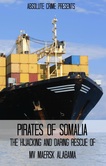Pirates of Somalia: The Hijacking and Daring Rescue of MV Maersk Alabama

The oceans can be a dangerous place; Captain Richard Phillips knew this. Still he never imagined what would happen to him or his crew on April 8, 2009, when Somalian pirates boarded and captured his ship.
With the gripping narrative of a page-turning thriller novel, this book recounts the capture of the Alabama by pirates, and the daring rescue of the hostages.
With the gripping narrative of a page-turning thriller novel, this book recounts the capture of the Alabama by pirates, and the daring rescue of the hostages.
Buy Now!
Pirates of Somalia PDF and ePub |
Excerpt
Prologue
Captain Richard Phillips stood before his ship, the Maersk Alabama. It was Wednesday, April 8, 2009. The day was early. The sun was just coming up, warming the small country of Djibouti. The captain inspected the American cargo vessel that he was in charge of. He heard the voices of his crew who had just climbed aboard. Laughter. Camaraderie. Unsuspecting. The captain’s mind wondered back to the messages he’d received from maritime safety groups in the days that led up to this one. Their messages were warnings. Each featured the same key word: Pirates. Captain Phillips took a deep breath through his nostrils, sucking in the fresh morning air. He released the breath of air from his mouth and climbed aboard the ship.
Chapter 1: Set Sail, Hark Back
The morning was unfolding, slowly brightening the further the Maersk Alabama sailed. They were headed for Mombasa in Kenya. The captain and his crew’s mission was to deliver 17,000 tonnes of cargo that included UN food aid for the starving peoples of Africa. The crew was busy but Captain Phillips’ mind was still distracted by that one word: pirates. Like a fish that had taken the bait his mind was unable to let go of it.
What did he know of pirates? the captain wondered to himself. He was aware of modern piracy. He’d seen the news. Seen the bandits clad in rags. Seen the AK-47s in the grip of their hands. Seen the mixed look of vexation and desperation in their eyes. Yet that very word ‘pirate’ conjured up stereotypical cartoonish images of men of the sea dressed in waistcoats and eye-patches and bandanas and brandishing cutlasses, led by a rum-swigging captain with a wooden leg, a flamboyant attire and a parrot on his shoulder.
The captain’s mind was taken on a journey back down memory lane where characters from his childhood still lurked, such as Blackbeard and Henry Morgan, and fictional representatives like Treasure Island’s Long John Silver and even Disney’s Peter Pan villain, Captain Hook. From so early on the legend of pirates had been romanticised by these variants. But Captain Phillips was an educated man. He knew what piracy’s origins really beheld.
The captain knew the very word ‘pirates’ wasn't the charming stuff of kids tales, but more like the Frankish and Saxon gangs of the sea who had ruthlessly plagued the waters of Armorica and Belgic Gaul in 286 AD. To rid them of their nuisance a hero was introduced in the form of Carausius – a Roman military commander who began life in simple circumstances but rose to power with his leadership and bravery. Taking reign of the Classis Britannica he entered battle on the waters, conquered the pirates and eliminated their threat.
Captain Phillips continued to steer the ship towards its final destination while his mind played out a history lesson from the depths of his learning. Like an opened treasure chest rich information poured out. The first known documented recording of official piracy was extracted and it dated back to the 14th century. On this document was stated the pirates in question of this era – the Sea Peoples who tormented southern Europe – the areas around the Aegean Sea in particular – and the eastern Mediterranean. Anatolia, Syria, Canaan, Cyprus and Egypt all came under invasion, a narrator read aloud from the document.
The captain’s eyes were fixed on the waters of the Indian Ocean ahead but upon them played out the most prominent period of piracy, which came between the Middle Ages and the 19th century. The waters had begun flourishing with commerce, setting forth the path that Captain Phillips and his men and the modern-day pirates would inherit.
A fast-forwarded montage skipped across the waters in front of the captain. During the extensive period between the Middle Ages and the 19th century tales had begun to emerge all around the world: East Asian pirates had started hijacking the silk and spice routes and preying on the junk trade of China; the notorious Vikings were savage warriors who commanded western Europe between the 8th and 12th centuries through their daring and violent raids; North Africa became known as the ‘Barbary Coast’ due to the looting carried out by the Barbary corsairs; and in North America during this period the legendary Blackbeard dominated the coasts, callously attacking ships that dared cross his path.
It was the Caribbean in particular, however, that experienced the greatest era of piracy with an extensive period that began around 1560 and lasted until the mid-1720s.
Captain Phillips’ fast-forwarded montage slowed down as attacks carried out on Spanish ships by the buccaneers and the domination of British-born Henry Morgan played out. Piracy in the Caribbean was rife due to the control Spain had of the islands, the history narrator reminded the captain. As a result of the rivalry European pirates from Britain, Portugal, France and the Netherlands often fought and raided the cargo ships that were occupied by the Spanish pirates.
His crewmen brought Captain Phillips’ attention back to the present. They were 400 miles east of Somalia’s capital, Mogadishu. The captain’s heart is strangled for a moment by the reminder of the word that has haunted him for days – pirates. As prevalent as piracy was in the past it never died out. Somali pirates now carried the flag of threat on the seas. And their stomping ground was the area in the Horn of Africa in which the Maersk Alabama was now dangerously headed into.
Captain Richard Phillips stood before his ship, the Maersk Alabama. It was Wednesday, April 8, 2009. The day was early. The sun was just coming up, warming the small country of Djibouti. The captain inspected the American cargo vessel that he was in charge of. He heard the voices of his crew who had just climbed aboard. Laughter. Camaraderie. Unsuspecting. The captain’s mind wondered back to the messages he’d received from maritime safety groups in the days that led up to this one. Their messages were warnings. Each featured the same key word: Pirates. Captain Phillips took a deep breath through his nostrils, sucking in the fresh morning air. He released the breath of air from his mouth and climbed aboard the ship.
Chapter 1: Set Sail, Hark Back
The morning was unfolding, slowly brightening the further the Maersk Alabama sailed. They were headed for Mombasa in Kenya. The captain and his crew’s mission was to deliver 17,000 tonnes of cargo that included UN food aid for the starving peoples of Africa. The crew was busy but Captain Phillips’ mind was still distracted by that one word: pirates. Like a fish that had taken the bait his mind was unable to let go of it.
What did he know of pirates? the captain wondered to himself. He was aware of modern piracy. He’d seen the news. Seen the bandits clad in rags. Seen the AK-47s in the grip of their hands. Seen the mixed look of vexation and desperation in their eyes. Yet that very word ‘pirate’ conjured up stereotypical cartoonish images of men of the sea dressed in waistcoats and eye-patches and bandanas and brandishing cutlasses, led by a rum-swigging captain with a wooden leg, a flamboyant attire and a parrot on his shoulder.
The captain’s mind was taken on a journey back down memory lane where characters from his childhood still lurked, such as Blackbeard and Henry Morgan, and fictional representatives like Treasure Island’s Long John Silver and even Disney’s Peter Pan villain, Captain Hook. From so early on the legend of pirates had been romanticised by these variants. But Captain Phillips was an educated man. He knew what piracy’s origins really beheld.
The captain knew the very word ‘pirates’ wasn't the charming stuff of kids tales, but more like the Frankish and Saxon gangs of the sea who had ruthlessly plagued the waters of Armorica and Belgic Gaul in 286 AD. To rid them of their nuisance a hero was introduced in the form of Carausius – a Roman military commander who began life in simple circumstances but rose to power with his leadership and bravery. Taking reign of the Classis Britannica he entered battle on the waters, conquered the pirates and eliminated their threat.
Captain Phillips continued to steer the ship towards its final destination while his mind played out a history lesson from the depths of his learning. Like an opened treasure chest rich information poured out. The first known documented recording of official piracy was extracted and it dated back to the 14th century. On this document was stated the pirates in question of this era – the Sea Peoples who tormented southern Europe – the areas around the Aegean Sea in particular – and the eastern Mediterranean. Anatolia, Syria, Canaan, Cyprus and Egypt all came under invasion, a narrator read aloud from the document.
The captain’s eyes were fixed on the waters of the Indian Ocean ahead but upon them played out the most prominent period of piracy, which came between the Middle Ages and the 19th century. The waters had begun flourishing with commerce, setting forth the path that Captain Phillips and his men and the modern-day pirates would inherit.
A fast-forwarded montage skipped across the waters in front of the captain. During the extensive period between the Middle Ages and the 19th century tales had begun to emerge all around the world: East Asian pirates had started hijacking the silk and spice routes and preying on the junk trade of China; the notorious Vikings were savage warriors who commanded western Europe between the 8th and 12th centuries through their daring and violent raids; North Africa became known as the ‘Barbary Coast’ due to the looting carried out by the Barbary corsairs; and in North America during this period the legendary Blackbeard dominated the coasts, callously attacking ships that dared cross his path.
It was the Caribbean in particular, however, that experienced the greatest era of piracy with an extensive period that began around 1560 and lasted until the mid-1720s.
Captain Phillips’ fast-forwarded montage slowed down as attacks carried out on Spanish ships by the buccaneers and the domination of British-born Henry Morgan played out. Piracy in the Caribbean was rife due to the control Spain had of the islands, the history narrator reminded the captain. As a result of the rivalry European pirates from Britain, Portugal, France and the Netherlands often fought and raided the cargo ships that were occupied by the Spanish pirates.
His crewmen brought Captain Phillips’ attention back to the present. They were 400 miles east of Somalia’s capital, Mogadishu. The captain’s heart is strangled for a moment by the reminder of the word that has haunted him for days – pirates. As prevalent as piracy was in the past it never died out. Somali pirates now carried the flag of threat on the seas. And their stomping ground was the area in the Horn of Africa in which the Maersk Alabama was now dangerously headed into.








